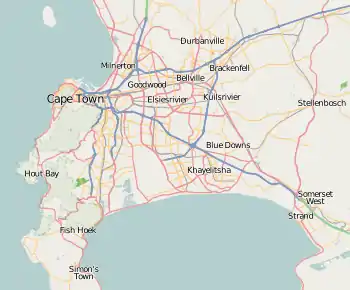Maclear's Beacon
Maclear's Beacon is a triangulation station used in the calculation of the curvature of the Earth.
 Location in Cape Town | |
| Coordinates | 33°58′01″S 18°25′32″E |
|---|---|
| Location | Table Mountain, Cape Town, South Africa |
| Designer | Thomas Maclear |
| Material | Rock |
| Height | 5 metres (16 ft) |
| Completion date | December 1844 |
| Dedicated to | Thomas Maclear |
The beacon is on top of Table Mountain in Cape Town, South Africa. It is situated on the Eastern end on the plateau of the mountain.

The beacon is 1,086 metres (3,563 ft) above sea level. Table Mountain’s 19 metres (62 ft) higher than the upper cable car station. The structure consists of man made rock packed in a triangle form, being 5 metres (16 ft) high. It was painted in lamp black colour to make it visible, when light shown on it.[1]
In December 1844, the Astronomer Royal at the Cape, Thomas Maclear,[2] instructed his assistant William Mann to build a beacon in the form of a pile of rocks which would be used to confirm and possibly expand on the existing curvature of the earth data of Nicolas-Louis de Lacaille. This data was in connection with the Cape arc of the meridian.[1] Initially the beacon had no name but in later years it was named after Maclear.[3]
In 1929, the pile of stones collapsed and it was restored in 1979 to commemorate the centenary of Maclear's death.[1]
The beacon is still used by cartographers today. It has become a tourist attraction and hiking trails over the mountain pass next to the beacon. It is also a National Monument.[4][1]
References
- Loos, Jackie (31 August 2017). "Jackie examines the history behind Macler's Beacon". Cape Argus.
- Anon (1870). The Royal Kalendar, and Court and City Register for England, Scotland, Ireland, and the Colonies. London: R & A Suttaby. p. 509.
- "Thomas Maclear". South African History Online. 17 February 2011. Retrieved 2018-07-26.
- "Maclear's Beacon: much more than just a mound of rocks". tablemountain.net. n.d. Retrieved 2018-07-26.
External links
 Media related to Maclear's Beacon at Wikimedia Commons
Media related to Maclear's Beacon at Wikimedia Commons